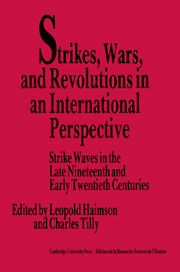 Strikes, Wars, and Revolutions in an International Perspective
Strikes, Wars, and Revolutions in an International Perspective Book contents
- Frontmatter
- Contents
- List of contributors
- Preface
- Part I Introductions
- 1 Theories and realities
- 2 The historical setting in Russia and the West
- Part II Models and realities
- Part III Workers in metal-processing enterprises in comparative perspective
- Part IV The effects of short-term variation
- Part V Conclusion
1 - Theories and realities
Published online by Cambridge University Press: 25 March 2010
- Frontmatter
- Contents
- List of contributors
- Preface
- Part I Introductions
- 1 Theories and realities
- 2 The historical setting in Russia and the West
- Part II Models and realities
- Part III Workers in metal-processing enterprises in comparative perspective
- Part IV The effects of short-term variation
- Part V Conclusion
Summary
Connections and comparisons
In what ways does the tide shape the beach, and the beach contain the tide? Clearly they depend on each other somehow, yet their interdependency is as subtle and hard to trace as is the connection between industrial and political conflict. Anyone who examines the history of World War I and its settlement in Europe, for example, notices the interplay among warmaking, wartime control of labor, mass strikes, and socialist bids for power. But in what sense, and how, did these varieties of conflict shape each other?
Formidable obstacles stand in the way of any straightforward answer to the question: the vagueness of such terms as “industrial and political conflict”; the variability of experience among countries, regions, and industries; the likelihood of further causes such as fluctuations in production and military expenditure; the probable complexity of any such causal web. Still, the relations badly need untangling. Our book follows some strands of the web within an important but relatively restricted frame: Europe and North America from 1890 to the early 1920s. It examines the interplay of politics and industrial conflict in Russia, Germany, France, Italy, Great Britain, and the United States.
Within that frame, we have a chance to make new, important comparisons. Fresh evidence concerning industrial conflict in Russia before the 1917 Revolution prompted the work that eventually produced this volume. Over the last decade, through research decribed in several papers appearing later in the book, it has become possible to document Russian strike activity by locality, industry, and period from 1890 to 1917 with far greater richness and accuracy than earlier researchers had managed.
- Type
- Chapter
- Information
- Strikes, Wars, and Revolutions in an International PerspectiveStrike Waves in the Late Nineteenth and Early Twentieth Centuries, pp. 3 - 17Publisher: Cambridge University PressPrint publication year: 1989
- 4
- Cited by


